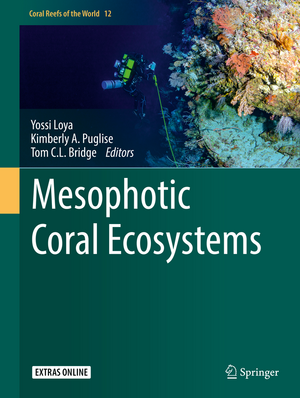Mesophotic Coral Ecosystems: Coral Reefs of the World, cartea 12
Editat de Yossi Loya, Kimberly A. Puglise, Tom C.L. Bridgeen Limba Engleză Hardback – 21 iun 2019
Din seria Coral Reefs of the World
- 18%
 Preț: 1118.62 lei
Preț: 1118.62 lei - 18%
 Preț: 946.72 lei
Preț: 946.72 lei - 18%
 Preț: 1385.37 lei
Preț: 1385.37 lei - 18%
 Preț: 1573.99 lei
Preț: 1573.99 lei - 18%
 Preț: 1240.93 lei
Preț: 1240.93 lei - 24%
 Preț: 1076.16 lei
Preț: 1076.16 lei - 15%
 Preț: 671.48 lei
Preț: 671.48 lei - 15%
 Preț: 658.37 lei
Preț: 658.37 lei - 18%
 Preț: 1696.30 lei
Preț: 1696.30 lei - 18%
 Preț: 1873.10 lei
Preț: 1873.10 lei - 24%
 Preț: 804.04 lei
Preț: 804.04 lei - 24%
 Preț: 811.65 lei
Preț: 811.65 lei - 24%
 Preț: 697.94 lei
Preț: 697.94 lei - 18%
 Preț: 1124.15 lei
Preț: 1124.15 lei - 24%
 Preț: 643.01 lei
Preț: 643.01 lei - 24%
 Preț: 930.25 lei
Preț: 930.25 lei - 24%
 Preț: 1249.89 lei
Preț: 1249.89 lei
Preț: 1937.46 lei
Preț vechi: 2549.30 lei
-24% Nou
Puncte Express: 2906
Preț estimativ în valută:
370.78€ • 385.67$ • 306.10£
370.78€ • 385.67$ • 306.10£
Carte tipărită la comandă
Livrare economică 10-16 aprilie
Preluare comenzi: 021 569.72.76
Specificații
ISBN-13: 9783319927343
ISBN-10: 3319927345
Pagini: 1024
Ilustrații: XV, 1003 p. 395 illus., 354 illus. in color.
Dimensiuni: 210 x 279 mm
Greutate: 2.88 kg
Ediția:1st ed. 2019
Editura: Springer International Publishing
Colecția Springer
Seria Coral Reefs of the World
Locul publicării:Cham, Switzerland
ISBN-10: 3319927345
Pagini: 1024
Ilustrații: XV, 1003 p. 395 illus., 354 illus. in color.
Dimensiuni: 210 x 279 mm
Greutate: 2.88 kg
Ediția:1st ed. 2019
Editura: Springer International Publishing
Colecția Springer
Seria Coral Reefs of the World
Locul publicării:Cham, Switzerland
Cuprins
Part I: Introduction.- 1. Mesophotic coral ecosystems: Introduction and Overview.- Part II: Regional Variation in Mesophotic Corarl Ecosystems.- 2. Bermuda.- 3. The Bahamas and Cayman Islands.- 4. Pulley Ridge, Gulf of Mexico, U.S.A..- 5. The Mesoamerican Reef.- 6. Discovery Bay, Jamaica.- 7. Puerto Rico.- 8. The United States Virgin Islands.- 9. Bonaire and Curaçao.- 10. Brazil.- 11. The Red Sea.- 12. The Chagos Archipelago.- 13. Ryukyus Islands, Japan.- 14. Taiwan.- 15. The Philippines.- 16. Palau.- 17. Pohnpei, Federated States of Micronesia.- 18. Papua New Guinea.- 19. North West Australia.- 20. The Great Barrier Reef and Coral Sea.- 21. Fiji. -22. American Samoa. -23. Cook Islands.- 24. French Polynesia.- 25. The Hawaiian Archipelago.- 26. Isla del Coco, Costa Rica, Eastern Tropical Pacific.- 27. Chile and Salas y Gómez Ridge.- Part III: Environments, Biodiversity, and Ecology of Mesophotic Coral Ecosystems. - 28. The mesophotic coral microbial biosphere.- 29. Macroalgae.- 30. Symbiodinium genetic diversity and symbiosis with hosts from shallow to mesophotic coral ecosystems.- 31. Large benthic foraminifera in low-light environments.- 32. Sponges.- 33. Biodiversity of reef‐building, scleractinian corals.- 34. Reef‐building corals of the upper mesophotic zone of the central Indo‐west.- Pacific.- 35. Sexual reproduction of scleractinian corals in mesophotic coral ecosystems vs. shallow reefs. -36. Coral sclerochronology: similarities and differences in the coral isotopic signatures between mesophotic and shallow reefs.- 37. Antipatharians of the mesophotic zone: four case studies.- 38. Octocorals of the Indo‐Pacific.- 39. Gorgonian corals.- 40. Fishes: Biodiversity.- 41. Disease problems.- 42. Light, temperature, photosynthesis, heterotrophy, and the lower depth.- limits of mesophotic coral ecosystems.- 43. Bioerosion.- 44. Geology and geomorphology.- Part IV: Are Shallow and Mesophotic Coral Ecosystems Connected?.- 45.Beyond the ‘deep reef refuge’ hypothesis: a conceptual framework to characterize persistence at depth.- 46. Coral ecosystem connectivity between Pulley Ridge and the Florida Keys.- Part V: Conservation, Management, and Threats to Mesophotic Coral Ecosystems.- 47. Disturbance in mesophotic coral ecosystems nd linkages to conservation and management.- 48. Invasive lionfish (Pterois volitans and P. miles ): distribution, impact, and Management.- 49. Ecosystem Services of mesophotic coral reefs and a call for better accounting.- Part VI: Mesophotic Coral Ecosystems Research: Technologies and Future Directions.- 50. Advanced Technical Diving.- 51. Underwater robotic technology for imaging mesophotic coral ecosystems.- 52. Key questions for research and conservation of mesophotic coral ecosystems and temperate mesophotic ecosystems.
Textul de pe ultima copertă
This book summarizes what is known about mesophotic coral ecosystems (MCEs) geographically and by major taxa. MCEs are characterized by light-dependent corals and associated communities typically found at depths ranging from 30-40 m and extending to over 150 m in tropical and subtropical ecosystems. They are populated with organisms typically associated with shallow coral reefs, such as macroalgae, corals, sponges, and fishes, as well as specialist species unique to mesophotic depths. During the past decade, there has been an increasing scientific and management interest in MCEs expressed by the exponential increase in the number of publications studying this unique environment. Despite their close proximity to well-studied shallow reefs, and the growing evidence of their importance, our scientific knowledge of MCEs is still in its early stages. The topics covered in the book include: regional variation in MCEs; similarities and differences between mesophotic and shallow reef taxa, biotic and abiotic conditions, biodiversity, ecology, geomorphology, and geology; potential connectivity between MCEs and shallow reefs; MCE disturbances, conservation, and management challenges; and new technologies, key research questions/knowledge gaps, priorities, and future directions in MCE research.
Caracteristici
Primary source for a basic understanding of Mesophotic coral ecosystems (MCEs) First reviews of major mesophotic taxa Looks into MCE’s geographical variations, similarities, differences between MCE’s and potential connectivity between MCEs and shallow reefs Covers the conservation, management and threats to MCEs and future research directions
